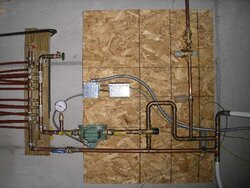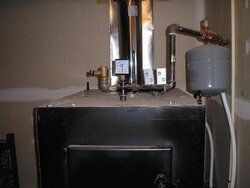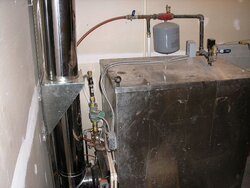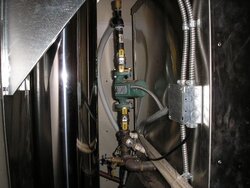As others have said, it sounds to me like the main problem is that you are trying to warm up a cold slab, which takes a LOT of BTU's - you either need throttle down the amount of heat going into the slab loop at any one time, and / or put a return temperature control on the boiler so that the boiler return temp stays above 140* as much as possible. Failure to do this risks flue gas condensation in the boiler and / or stack which can result in major corrosion and failure of the boiler - the pattern of which is pretty obvious, and is NOT covered by any manufacturer warranties....
Having a return temperature control loop is probably the safest approach as it will keep you covered no matter what else is going on in your loads. Next throttle the amount of heat going into the slab at any one time so that you will have enough left for your other loads.
The other concern raised is that of a power fail / pump fail dump zone, which it sounds like you don't really have at present... This a system you should have as protection for the situation where you have just gotten a full load of wood going and the power goes out, a pump quits, or there is some other system failure that causes your normal distribution method to fail, including a boiler over-temp situation for any reason. While a power-failure or boiler overtemp should shut down the fans and reduce the air to the fire, it WILL continue to burn for some time, and produce heat, potentially leading to steam producing temperatures, boiler damage, popping the pressure valve, etc...
Since part of the potential failure scenarios include power failures, the first rule for dump zone design is that it must work without power, and without human intervention. This essentially means it needs to rely on a convection powered gravity or thermosiphon loop, where the hot water rises out of the boiler, cools, and then flows back to the boiler. It needs to be able to get rid about 20% of the boilers rated output. In order for a gravity loop to work, it must be fairly large bore, and not have any major flow restrictions, or dips that would act as thermal flow breaks - and the cooling area needs to be above the boiler. Sometimes one can use existing baseboard loops, possibly with some extra plumbing to bypass pumps and zone controls, but often the easiest way is to run an extra loop of fin-tube around the ceiling of the boiler room. Control is often done by using an "automag" valve, which is a normally open valve that is held closed by the presence of a small amount of electric power. In the event of a power failure or overtemp shutdown, the automag looses power, opens, and the heat flows into the dump zone. (Note that since this is stuff that just sits in the boiler room, it doesn't have to be pretty, many people get their dumpzone fin-tube from the scrap yard, or discounted "scratch & dent" from the plumbing supplier)
Gooserider





